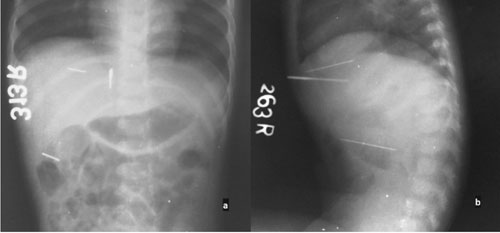Until the publication of Kempe, et al. [1] paper in 1962, child
abuse was an under-recognized and under-reported entity. Now, more than
half a century later, there is clear evidence that child abuse, also
known as non-accidental trauma (NAT), is a global problem.
A 14-month-old girl weighing 5 kg was brought to the
casualty services of our hospital by her mother with complaints of pain
in the abdomen and persistent crying. The mother informed the physicians
of her suspicion of rodent-bite while she was away doing household
chores. A careful examination revealed a single pin-head sized puncture
mark in the epigastric region. A sharp tip of a single foreign body was
palpable just below the puncture mark. There were no external injuries
over rest of the abdomen. A plain abdominal radiograph showed three
linear foreign bodies (Fig. 1a). On lateral films, the
objects appeared to be intra-abdominal, traversing more than half of the
depth of the abdomen (Fig. 1b). It then became clear that
all three linear objects were inserted one after the other, through a
single puncture site in epigastrium. A medicolegal case was registered.
An exploratory laparotomy was undertaken and the first foreign body,
identified as rusted sewing needle, was retrieved from the sub-hepatic
region, entangled within the omentum. The other two, which were embedded
deep within the liver parenchyma with just the tips on liver surface,
were retrieved through a separate incision. Rest of the solid organs and
bowel were normal. Postoperative period was uneventful and patient was
discharged after completing medico-legal procedures.
 |
|
Fig. 1 Plain abdominal antero-posterior
(a) and lateral (b) abdominal radiograph showing needles in
abdominal cavity.
|
Although it is generally believed that child abuse is
mainly a social issue, with heavy involvement of social workers and
child protective services, these children often need to be primarily
treated as trauma cases, as a large proportion of them have severe and
life-threatening injuries [2]. Not only do they need complete evaluation
of the presenting acute injury, but also the subtle underlying sub-acute
and chronic injuries, which may increase the morbidity during their
treatment. As often the injuries may be life threatening and hidden, it
requires high degree of suspicion and timely intervention.
Out-of-the-box thinking is required in order to tackle a peculiar
clinical situation.
References
1. Kempe CH, Silverman FN, Steele BF, Droegemueller
W, Silver HK. The battered-child syndrome. JAMA. 1962; 181:17-24.
2. Naik-Mathuria B, Akinkuotu A, Wesson D. Role of the surgeon in
non-accidental trauma. Pediatr Surg Int. 2015;31:605-10.

